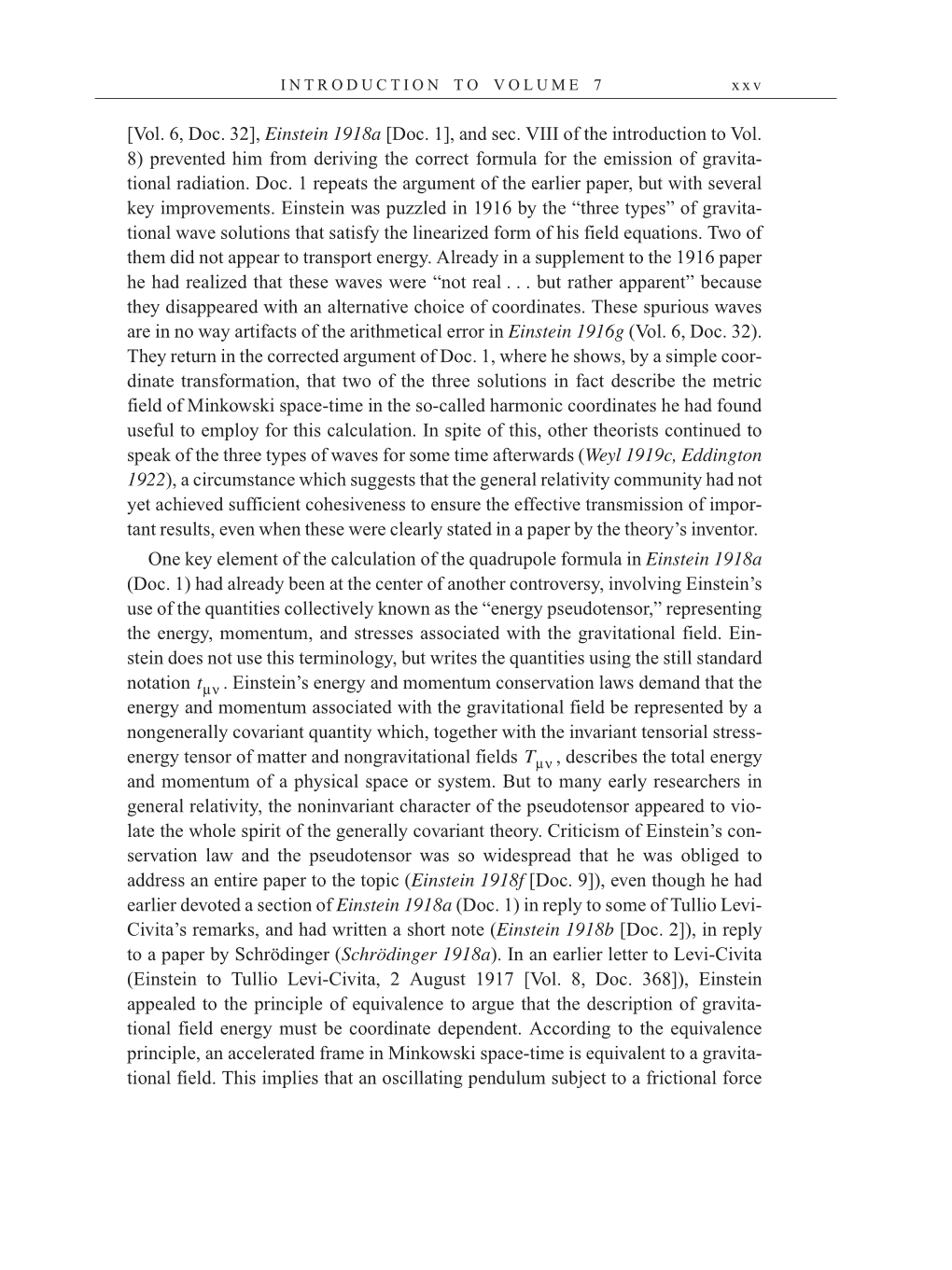I N T R O D U C T I O N T O V O L U M E 7 x x v
[Vol. 6, Doc. 32], Einstein 1918a [Doc. 1], and sec. VIII of the introduction to Vol.
8) prevented him from deriving the correct formula for the emission of gravita-
tional radiation. Doc. 1 repeats the argument of the earlier paper, but with several
key improvements. Einstein was puzzled in 1916 by the “three types” of gravita-
tional wave solutions that satisfy the linearized form of his field equations. Two of
them did not appear to transport energy. Already in a supplement to the 1916 paper
he had realized that these waves were “not real . . . but rather apparent” because
they disappeared with an alternative choice of coordinates. These spurious waves
are in no way artifacts of the arithmetical error in Einstein 1916g (Vol. 6, Doc. 32).
They return in the corrected argument of Doc. 1, where he shows, by a simple coor-
dinate transformation, that two of the three solutions in fact describe the metric
field of Minkowski space-time in the so-called harmonic coordinates he had found
useful to employ for this calculation. In spite of this, other theorists continued to
speak of the three types of waves for some time afterwards (Weyl 1919c, Eddington
1922), a circumstance which suggests that the general relativity community had not
yet achieved sufficient cohesiveness to ensure the effective transmission of impor-
tant results, even when these were clearly stated in a paper by the theory’s inventor.
One key element of the calculation of the quadrupole formula in Einstein 1918a
(Doc. 1) had already been at the center of another controversy, involving Einstein’s
use of the quantities collectively known as the “energy pseudotensor,” representing
the energy, momentum, and stresses associated with the gravitational field. Ein-
stein does not use this terminology, but writes the quantities using the still standard
notation . Einstein’s energy and momentum conservation laws demand that the
energy and momentum associated with the gravitational field be represented by a
nongenerally covariant quantity which, together with the invariant tensorial stress-
energy tensor of matter and nongravitational fields , describes the total energy
and momentum of a physical space or system. But to many early researchers in
general relativity, the noninvariant character of the pseudotensor appeared to vio-
late the whole spirit of the generally covariant theory. Criticism of Einstein’s con-
servation law and the pseudotensor was so widespread that he was obliged to
address an entire paper to the topic (Einstein 1918f [Doc. 9]), even though he had
earlier devoted a section of Einstein 1918a (Doc. 1) in reply to some of Tullio Levi-
Civita’s remarks, and had written a short note (Einstein 1918b [Doc. 2]), in reply
to a paper by Schrödinger (Schrödinger 1918a). In an earlier letter to Levi-Civita
(Einstein to Tullio Levi-Civita, 2 August 1917 [Vol. 8, Doc. 368]), Einstein
appealed to the principle of equivalence to argue that the description of gravita-
tional field energy must be coordinate dependent. According to the equivalence
principle, an accelerated frame in Minkowski space-time is equivalent to a gravita-
tional field. This implies that an oscillating pendulum subject to a frictional force
tμν
Tμν
